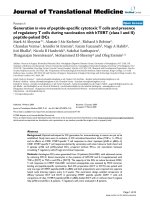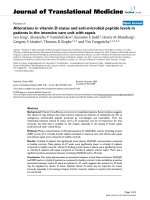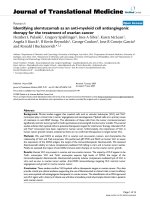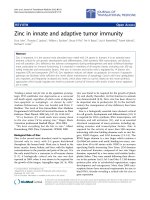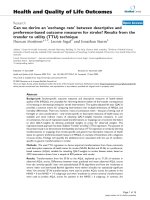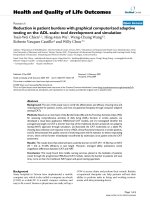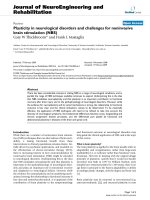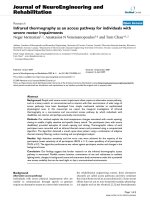báo cáo hóa học:" Pain in cancer. An outcome research project to evaluate the epidemiology, the quality and the effects of pain treatment in cancer patients" pptx
Bạn đang xem bản rút gọn của tài liệu. Xem và tải ngay bản đầy đủ của tài liệu tại đây (272.6 KB, 7 trang )
BioMed Central
Page 1 of 7
(page number not for citation purposes)
Health and Quality of Life Outcomes
Open Access
Research
Pain in cancer. An outcome research project to evaluate the
epidemiology, the quality and the effects of pain treatment in
cancer patients
Giovanni Apolone*
1
, Oscar Bertetto
2
, Augusto Caraceni
3
, Oscar Corli
4
,
Franco De Conno
3
, Roberto Labianca
5
, Marco Maltoni
6
, Mariaflavia Nicora
7
,
Valter Torri
8
, Furio Zucco
9
and the Cancer Pain Outcome Research Study
Group
Address:
1
Laboratorio di Ricerca Traslazionale e di Outcome, Dipartimento di Oncologia, Istituto di Ricerche Farmacologiche "Mario Negri", Via
Eritrea 62, 20157 Milan, Italy,
2
Oncologia Medica, Ospedale Molinette, C.so Bramante 88, 10126 Turin, Italy,
3
Unità Operativa Cure Palliative,
Istituto Nazionale dei Tumori, Via Venezian 1, 20123 Milan, Italy,
4
Unità Operativa Cure Palliative, Istituti Clinici di Perfezionamento, P.O.
"Vittore Buzzi", Via Castelvetro 32, 20154 Milan, Italy,
5
Oncologia Medica, Ospedali Riuniti di Bergamo, Largo Barozzi 1, 24100 Bergamo, Italy,
6
Hospice Forlimpopoli, ASL Forli Cure Palliative Via Duca D'Aosta 33, 47034 Forlimpopoli (FC), Italy,
7
Direzione Medica, Grunenthal-Formenti,
Via Correggio 43, 20149 Milan, Italy,
8
Laboratorio di Ricerca Clinica Oncologica, Dipartimento di Oncologia, Istituto di Ricerche Farmacologiche
"Mario Negri", Via Eritrea 62, 20157 Milan, Italy and
9
Hospice Garbagnate, Cure Palliative AO Salvini Viale Forlanini, 121 20024 Garbagnate
Milanese (MI), Italy
Email: Giovanni Apolone* - ; Oscar Bertetto - ;
Augusto Caraceni - ; Oscar Corli - ; Franco De
Conno - ; Roberto Labianca - ; Marco Maltoni - ;
Mariaflavia Nicora - ; Valter Torri - ; Furio Zucco -
* Corresponding author
Abstract
Background: Management of pain related to advanced or metastatic cancer, although the availability of
several pharmacological and non-pharmacological interventions and the existence of well-known
guidelines and protocols, is often difficult and inadequate. Evidence of the relative effectiveness of current
options for treating cancer pain from comparative randomized studies is scanty.
Methods: In the context of a wider project, a multicenter, open label, prospective Outcome Research
study will be launched in Italy in 2006 to investigate the epidemiology of cancer pain and of its treatments,
the quality of analgesic-drug therapy and the effectiveness of alternative analgesic strategies in a large,
prospective, unselected cohort of cancer patients using the state-of-the art of patient-reported-outcomes.
About 100 Italian centers will recruit 2500 patients with advanced/progressive/metastatic cancer with pain
(related to the cancer disease) requiring analgesic treatments. Each center is expected to recruit 25
consecutive and eligible patients during the study inception period. Approximately two months will be
allowed for subject recruitment and enrollment. Subject evaluation and follow-up will be for 3 months.
The effect on outcomes of various therapeutic analgesic options administered by physicians, given the
observational approach where patients are not assigned at random to different treatments, will be
compared using the propensity score approach, allowing the adjustment for treatment selection bias.
Later, after the launch of the observational study and on the basis of results, in specific subsamples of
patients and in select centers of the network, a Randomized Controlled Trial will be carried out to
formally compare the efficacy of alternative analgesic strategies, with particular emphasis on oral morphine
(as comparator) and buprenorphine patch (as experimental arm). Results from the outcome (cohort) and
experimental (Randomized Controlled Trial) studies will ensure both the external and internal validity.
Published: 02 February 2006
Health and Quality of Life Outcomes 2006, 4:7 doi:10.1186/1477-7525-4-7
Received: 28 July 2005
Accepted: 02 February 2006
This article is available from: />© 2006 Apolone et al; licensee BioMed Central Ltd.
This is an Open Access article distributed under the terms of the Creative Commons Attribution License ( />),
which permits unrestricted use, distribution, and reproduction in any medium, provided the original work is properly cited.
Health and Quality of Life Outcomes 2006, 4:7 />Page 2 of 7
(page number not for citation purposes)
Background
Pain afflicts most cancer patients, mainly in the advanced
and metastatic phase of the disease [1]. Recent reviews of
published literature suggest that the prevalence of pain in
advanced cancer is about 70% with ample variations
according to the cancer type and disease stage [2].
Despite the existence of published and well-known guide-
lines for cancer pain management recommended by the
World Health Organization (WHO) and effective treat-
ments are available for 70–90% of cases [3], under treat-
ment is well documented and large proportions of cancer
patients (reaching in some evaluations 40%) remain
intentionally under-treated [4] for several reasons, often
conceptualized in terms of barriers related to health care
provider, patient, family, institution and society [5]. The
most frequent cause of under-treatment is usually consid-
ered misconceptions about opioids [6].
Evidence about pain prevalence, drug utilization and
treatments effectiveness in cancer patients are scanty,
most deriving from placebo trials, with very few compar-
ative studies in large and well characterized cohorts of
cancer patients. Furthermore, it is not available in medical
literature any large parallel randomized controlled trial
conducted in advanced cancer patients suffering from
severe pain (step 3 in the WHO's pain ladder), comparing
any alternative opioids to oral morphine [7-10].
The general picture that derives from the analysis of expe-
riences carried out in international settings does apply to
Italy also, with some peculiarities: a) Opioids consump-
tion is ranked among the lowest in Europe until 2000,
with some improvements at least in terms DDD/100,000
people after the introduction of new opiods in the list of
reimbursable drugs (transdermal fentanyl and morphine
syrup) in 2000 [11]. b) Until January 2005, when a new
bill was introduced at national level, no WHO-step II
analgesic products were available in the list of reimbursa-
ble drugs in most of Italian regions, as well as some
"strong" WHO-step III opioids, making it difficult for
physicians the appropriate prescription of drugs and cre-
ating variability in drugs utilization across different Italian
regions. c) A non appropriate use of transdermal fentanyl
can be suspected, as too many patients received it as first
option, although recommended only when oral mor-
phine is inadequate [12].
A multidisciplinary Advisory Board of experts in the field
of cancer and pain treatments from Industry, Scientific
Societies and Patients Associations was convened by the
Mario Negri Institute on November 2003 to discuss the
quality of pain management in cancer patients in Italy
and, eventually, to recommend possible ameliorative
educational and research strategies. Member of the Boards
highlighted the lack of and the need for new empirical evi-
dence about the epidemiology and the effectiveness of
available therapeutic strategies, and called for a prospec-
tive program of research aimed at making available to
treating physicians, patients and families valid informa-
tion about pain management in cancer. Two main lines of
activities were identified as necessary: information and
education activities addressed to physicians, care givers
and patients/citizens, and prospective data collection to
document patterns of care and outcomes.
Operationally, some working groups met several times
during 2004, identified a selected sample of about 100
centers treating cancer patients with advanced/metastatic
disease and pain that could be potentially eligible for a
prospective study, and planned 3 types of activities to be
implemented during the following 3 years (2005–2007):
a) information and education: a prototype of educational
course for professionals (physicians and nurses) has been
assembled and tested on a sample of participants
(through a residential course approved by the Italian
Committee for Medical Continuing Education with 26
and 33 credits for physicians and nurses, respectively); a
critical appraisal of information available in the web
(Internet) was also carried out with the preparation and
publication of a meta-site that facilitates the use of
selected (internet) resources for people interested and/or
involved in issues related to cancer pain [13]; b) drug uti-
lization and appropriateness: an evaluation of the volume
and quality of prescriptions of analgesic drugs in a large
administrative data base in collaboration with local Ital-
ian Health Authorities has been started to test the feasibil-
ity of the approach in a wider context (regional); c) a
prospective, multicenter, nationwide effectiveness study
to test the effect of different and alternatives analgesic
strategies (such as oral morphine, fentanyl and buprenor-
phine patches, etc) on patient-reported-outcomes.
The above initiatives are fully described elsewhere
[14,15]. In the present paper we provide details about the
prospective multicenter study, involving more than 100
Italian centers that has the objective to assess the epidemi-
ology and quality of different and alternatives analgesic
strategies (such as oral morphine, fentanyl and buprenor-
phine patches, etc) and their effect on patient-reported-
outcomes. Results are expected by the end of 2006.
Study rationale
Evidence of the relative effectiveness of current options for
treating cancer pain from comparative randomized stud-
ies is scanty. This study will investigate the epidemiology
of cancer pain and of its treatments, the quality of analge-
sic-drug therapy and the effect of alternative analgesic
strategies in a large, prospective, unselected cohort of can-
cer patients using the state-of-the art of patient-reported-
Health and Quality of Life Outcomes 2006, 4:7 />Page 3 of 7
(page number not for citation purposes)
outcomes. Later, Later, after the launch of the observa-
tional study and on the basis of results, in specific sub-
samples of patients, in select centers, a Randomized
Controlled Trial (RCT) will be carried out to formally
compare the efficacy of alternative analgesic strategies,
with particular emphasis on oral morphine as comparator
and buprenorphine patch as experimental arm. Results
from the outcome and experimental studies will ensure
both the external and internal validity. This kind of
approach - a comprehensive cohort design study where all
participants are followed up regardless of their randomi-
zation status, and outcomes of people who participated in
the RCT can be compared with those who participated in
the cohort study to assess their similarities and differences
- is ideal for trials in which large proportions of eligible
individuals are likely to be not entered in the RCT [14,16-
18].
Objectives
Primary objective
- To describe the characteristics of a large sample of cancer
patients in terms of case mix (patients characteristics),
pattern of care (pharmacological and non-pharmacologi-
cal treatments) and relevant efficacy (analgesic and other
patient-reported outcomes (PRO) outcomes such satisfac-
tion, quality of life measures) and safety outcomes
(generic, disease and treatments specific).
- To assess the quality of analgesic treatments in terms of
congruence between patients' reported level of pain
(intensity) and the potency of the prescribed analgesic
drug (according to the WHO analgesic ladder) [19].
Secondary objectives
The database will be used to evaluate the effects of various
therapeutic analgesic options administered by physicians
to patients. Given the observational setting, outcomes of
subjects who were not assigned at random to different
treatments will be compared using the propensity score
approach, allowing the adjustment for treatment selection
bias [20], as recently done in some large observational
population studies [21,22]. The reference group will be
those patients treated with oral morphine. The propensity
analyses will be carried out:
- To evaluate the effectiveness of treatment regimens on
pain intensity and patient-reported quality of life
- To evaluate the effect of treatment regimens on patient-
reported satisfaction
- To evaluate the safety profile (adverse and side effects) of
alternative treatment regimens
Methods
Study design
This study will be designed as a multi-center, open-label,
observational non-interventional trial in at least 100 cent-
ers, in Italy. Approximately 25 subjects will be enrolled in
each center. Subjects will be treated by physicians accord-
ing to the usual practice (standard of care) and followed
over time using standardized methods and forms to make
possible a valid and reliable description of case-mix, pat-
tern of care and outcomes. Subjects will be monitored to
evaluate the analgesic effects for 28 days (4 weeks) and
then with a simplified scheme for further 8 weeks.
Scheduled study specific assessments will be done as
follows (Table 1)
- Baseline assessment (First visit).
Table 1: Schedule of assessments and procedures
Procedure Study Day
Screening
baseline
Day 1*
Telephone
contact 1
Day 2
Telephone
contact 2
Day 3
Visit Day
4
Visit Day
7*
Visit Day
14*
Visit Day
21*
Visit Day
28*
Final Visit
Week 12
*
Informed consent x - -
Eligibility criteria x - - - - - - - -
Study registration x - -
Medical history x - - - - - - - x
Physical examination x - - x x x x x x
Analgesic consumption x - - -xxxxx
Pain assessment (BPI) x x x x x x x x x
Symptoms and Side effects
assessment
x x x xxxxxx
Patient global assessment x - - - x x x x x
Physician global assessment x - - x x x x x
HRQOL x - - - x x x x x
*mandatory
Health and Quality of Life Outcomes 2006, 4:7 />Page 4 of 7
(page number not for citation purposes)
- Telephone contacts 24 and 48 hours after the inclusion
(facultative).
- Visit at day 7,14,21,28.
- Final complete assessment at month 3 (12 weeks from
inclusion and 8 from last complete evaluation) regarding
patients' (analgesic and non-analgesic) outcomes and
vital status; a summary of treatments delivered during the
period is also planned.
Subject population
All patients, either new cases or already followed-up at the
participating centers, with eligible (advanced or meta-
static) solid cancers and with pain (related to cancer dis-
ease) requiring any treatment are eligible to be included
during the study inception period.
Study period and number of cases per-center
Each center is expected to recruit 25 consecutive and eligi-
ble patients during the study inception period.
Approximately two months will be allowed for subject
recruitment and enrollment. Subject evaluation and fol-
low-up will be for 3 months.
Study conduct and supervision
In order to be able to conduct and monitor the progress of
the trial for the patients' safety and according to the World
Medical Association Declaration of Helsinki and the Euro-
pean and Italian Good Clinical Practice guidelines, as well
as to establish and guide the Group publication policy,
several Committees, Boards and Groups have been assem-
bled and organized in a pre-planned Trial Structure and
Organization, with explicit guidance for its functioning.
Basically, 4 hierarchical bodies will be created: an Advi-
sory Board, a Steering Committee, a Protocol Writing
Committee and a Project Management Group (Appendix
1 [see Additional file 1]). If necessary, a Committee for
Ancillary Studies (CAS) will be also activated.
Entry criteria
All patients seen at the participating centers during the
study inception period will be screened, and if considered
eligible included, registered and monitored over time.
After a check of the eligibility and inclusion in the study,
the investigator will assign treatments to patients accord-
ing to the standard practice (usual care). In the case of pre-
scription of WHO step-II and -III drugs, appropriate
strategies will be recommended to reach the adequate
individual pain control, with particular attention to titra-
tion, identification and management of side effects.
Eligibility (inclusion) criteria
The study will include patients:
1. with diagnostic (histological or cytological) evidence of
advanced/progressive/metastatic solid tumor;
2. with pain, any degree of intensity (assessed on a numer-
ical scale from 0 to 10 by asking the patient to rate the
average intensity of his/her pain over the last 24 hours),
related to cancer, requiring analgesic treatment or already
on analgesic treatment;
3. with age ≥ 18 years;
4. with a life expectancy of greater than 1 month;
Exclusion criteria
A subject must not meet any of the following exclusion
criteria to be eligible in the study:
1. the subject is less than 18 years of age;
2. the subject is participating in other research projects
that conflict or may confound the results of the present
study;
3. the subject is unwilling or unable to provide a valid
consent for the participation;
4. the subject has some medical conditions, including psy-
chiatric/mental illness, severe senile or Alzheimer' demen-
tia, substance abuse, deemed by the Investigator to be
likely to interfere with participation and compliance with
the study protocol;
5. the subject cannot guarantee regular follow-up visits for
logistic or geographic reasons.
Study medications (drugs supply) and other medical
procedures
Pharmacological and non-pharmacological interventions,
prescribed by physicians in the context of their best prac-
tice for cases included in the prospective cohort study are
provided free as in all centers they are standard care for
patients requiring analgesic treatments for pain control,
according to each center and investigator policy. In the
case a RCT will be activated in the context of the study,
drugs compared in the RCT part of the study will be fur-
nished by the Sponsor(s).
All medications must be documented on the CRF.
Informed consent
Subjects must be able to provide valid written consent,
approved by the local Ethics Committee centrally by the
study coordinating center.
Health and Quality of Life Outcomes 2006, 4:7 />Page 5 of 7
(page number not for citation purposes)
Subject enrollment
After consent is obtained, a subject will be enrolled when
he/she meets all the inclusion criteria and none of the
exclusion criteria. A sequential site-patient number will be
assigned.
Baseline Assessment
After enrollment/inclusion, the following screening
assessments will be performed and recorded: a) medical
history including past cancer history, b) physical examina-
tion, c) recording of medications and recent therapies,
including analgesic consumption, d) pain assessment
using the Brief Pian Inventory (BPI), e) symptoms and
side effects assessment, f) patient and physician global
assessment (PGA), g) patient's self-reported health-related
quality-of-life (HRQOL).
Follow-up assessments
According to the flow-chart (Table 1), some evaluations
are recommended and others are compulsory. In addition
to the first baseline assessment, the following evaluations
are mandatory: day 7,14,21,28.
Final (end-of-study) visit
At week 12 (3 months after the inclusion) a complete re-
assessment is required: a) medical history including past
cancer history, b) physical examination, c) recording of
medications and recent therapies, including analgesic
consumption, d) pain assessment using the BPI, e) symp-
toms and side effects assessment, f) patient and physician
global assessment, g) patient's self-reported health-related
quality-of-life.
Pain assessment
Pain will be assessed with the BPI [19,23,24] which will
be administered at baseline, at day 7, 14,21,28 and at
week 12 (3 months) when patients will attend regular vis-
its at the center or during admission or at home depend-
ing on the setting of care (outpatient clinic, hospice,
hospital unit, home care).
Quality of analgesic care assessment
The quality of analgesic treatments will be cross-section-
ally assessed in terms of congruence between the patients'
reported level of pain (intensity) and the potency of the
prescribed analgesic drug (according to the WHO analge-
sic ladder). Operationally, self-reported pain intensity
(from the BPI) and the level of most potent analgesic pre-
scribed (from the CRF) will be combined to assemble a
Index of Pain Management (IPM) that ranges from -3 (a
patient with severe pain receiving no analgesic drugs) to
+3 (a patient receiving morphine or an equivalent drug an
reporting no pain) [19]. Data collected longitudinally will
be used to test the validity and yield of other dynamic
approaches to assess the quality of analgesic care at indi-
vidual level.
Quality of life and other relevant patient reported
outcomes
Quality of life, satisfaction measures and symptoms/side
effects check-lists will be administered to patients when
planned during the follow-up [25-27].
Information about all pain medications and number of
rescue doses assumed by patients will be also recorded in
the CRF.
Safety issues
All adverse events, serious and non-serious, as well as
generic, disease and treatment specific symptoms,
encountered during the clinical study will be reported on
the appropriate page of the CRF.
Sample size estimates
According to data available from the literature and to pre-
liminary results from an ongoing observational Italian
study [28], we may assume that 100 centers during a
inception (recruitment) period of 2 months can include
and evaluate about 2.500 eligible cases. Half of them will
be already receiving a WHO-step III treatment. Most
(60%) of the remaining 1250 will eventually need a
WHO-Step III analgesic drug (750) during the longitudi-
nal evaluation period.
Overall, considering the inception and the longitudinal
evaluation, the entire duration of the study is estimated
around 5 months. At the moment, more than 160 centers
accepted to participate and 130 have successfully carried
out a pilot phase of the study to test the study feasibility
(Appendix 2 [see Additional file 2]).
Data analysis and statistics
According to the first main objective of the study (i.e., to
describe the characteristics of cancer patients in terms of
patients characteristics, pharmacological and non-phar-
macological treatments and relevant analgesic and other
PRO outcomes such as satisfaction, quality of life, generic,
disease and treatments specific side effects), all patients
enrolled in the study and eligible will be included in the
statistical descriptive analyses. To avoid and minimize the
impact of missing data, a bias that may be present in the
case of using patient-reported measures as principal out-
comes/endpoints [29-32], particularly when patients dis-
continue study treatment, specific procedures to treat
missing items will be used, such as the last observation
carried forward -LOCF. Data will be analyzed using either
parametric and non-parametric statistical tests. When
appropriate, for example for the weekly pain ratings
scales, scores will be analyzed using repeated analyses of
Health and Quality of Life Outcomes 2006, 4:7 />Page 6 of 7
(page number not for citation purposes)
variance to analyze and separate the effects of treatments
and time and test the interaction between the two, as well
[33].
As to the assessment of the quality of analgesic care, the
adequacy of pain management will be assessed firstly
using the IPM, an index assembled by grouping with
explicit and pre-planned rules patient with different inten-
sity of pain and level of analgesic therapies [19]. Although
IPM is not accurate for prescribing drug to an individual,
it provides a rough estimate of how pain is treated in the
population. According to the literature, each patient will
be classified into one of seven mutually exclusive levels of
care (from -3 to +3) and appropriate univariate and mul-
tivariate analyses will be carried out on the whole sample
and on relevant sub-groups to screen predictors of poor
analgesic care and to identify patients at greater risk of
under-medication. Data collected over time will be used
to develop and test new methods to assess quality of anal-
gesic care that may be used at individual (single case)
level.
As to the secondary objective of the study (i.e., to evaluate
the effects of various therapeutic analgesic options admin-
istered by physicians to patients), given the non-rand-
omized design the propensity score approach [20-22] will
be used to balance the covariates in the groups and thus
reduce the bias produced by the lack of randomization.
Briefly, in all 3 comparisons planned by protocol (oral
morphine vs fentanyl patch, oral morphine vs buprenor-
phine patch, fentanyl vs buprenorphine), a comparison
specific propensity scores will be estimated. The propen-
sity score method implies a comprehensive collection of
information known to be causally associated with the
choice of the treatments, then the production of a propen-
sity score (the conditional probability of exposure to a
treatment given the observed covariates) using standard
statistical models such as logistic regressions to predict the
treatment (for example, the choice of morphine in eligible
patients), eventually the comparison of outcomes (for
example, pian intensity) by matching or stratifing patients
according to the value of the propensity scores.
Study endpoints
The Study will collect, describe and assess a vast array of
outcomes measures related to pain and to its impact on
patients' life. Some of these measures will be collected and
reported by physicians and other directly by patients.
Pain related outcomes
The predefined primary outcome measurement is the pain
intensity over the first weeks, assessed with four questions
from the BPI, that will be used either individually or after
the computation of their mean, as indicated by developers
[19,23,24]. The relevant endpoint is the reduction in
worst and average pain score of ≥ 2 points (pain intensity
difference, PID, >/= 2) at week 4 (day 28 from inclusion)
over baseline.
Other endpoints
Escape/Rescue pain medications: counts of rescue/escape
medications taken to control pain from inclusion to week
4 (day 28 from inclusion).
Adequacy of analgesic-drug therapy: Patient Management
index (PMI), categorized in a binary variable according to
negative (indicating inadequate analgesic care) and posi-
tive (conservative indicator of acceptable treatment) lev-
els.
Other patient-reported endpoints:HRQOL, Satisfaction
with (drugs) treatment, rate and severity of symptoms,
adverse and side effects.
Ethical approval and publication policy
Before entering patients into the cohort study, clinicians/
investigators must ensure that the Protocol has received
clearance from the Local Research Ethics Committee (L-
REC). The patients' consent to participate in the studies
should be obtained after a full explanation has been
given. Particular attention should be given to explaining
the purposes, manner of the management and use of the
patients' data from questionnaires and diaries. The right
of the patient to withdraw from the studies in any time,
without giving reasons, must be respected.
The responsibility for drafting the manuscripts related to
the analyses described in this protocol will lie with the
WPC whose members will be the primary Authors. At least
one representative from high-recruiting centers will be
included among the co-authors, and all participants will
be acknowledged in the Appendices. All authors should
review and approve the manuscript before submission. At
least two papers are expected: the first reporting on the
results of the "epidemiological" part of the study, includ-
ing a description of patients' characteristics in terms of
baseline socio-demographic and clinical variables, pattern
of care and main outcomes, and a discussion of the feasi-
bility of this kind of approaches in the specific setting, the
second about the effects (effectiveness) of treatments on
patients (and physicians) reported outcomes.
Additional material
Additional File 1
Appendix 1. Advisory Board, Steering Committee, Protocol Writing Com-
mittee and Project Management Group
Click here for file
[ />7525-4-7-S1.doc]
Publish with BioMed Central and every
scientist can read your work free of charge
"BioMed Central will be the most significant development for
disseminating the results of biomedical research in our lifetime."
Sir Paul Nurse, Cancer Research UK
Your research papers will be:
available free of charge to the entire biomedical community
peer reviewed and published immediately upon acceptance
cited in PubMed and archived on PubMed Central
yours — you keep the copyright
Submit your manuscript here:
/>BioMedcentral
Health and Quality of Life Outcomes 2006, 4:7 />Page 7 of 7
(page number not for citation purposes)
Acknowledgements
The study was supported by Grunenthal-Formenti (Italy) with a unre-
stricted educational grant.
References
1. Cherny N: The management of cancer pain. Cancer J Clin 2000,
50:70-116.
2. Hearn J, Higginson IJ: Cancer pain epidemiology: a systematic
review. In Cancer Pain, Assessment and Management Edited by: Bruera
ED, Portenoy RK. Cambridge University Press; 2003.
3. WHO Cancer Pain Relief: with a Guide to Opioid Availability 2nd edition.
WHO, Geneva, 1996. WHO, Geneva; 1990.
4. Cohen MZ, Easley MK, Ellis C, Hughes B, Ownby K, Rashad BG, Rude
M, Taft E, Westbrooks JB: Cancer Pain Management and the
JCAHO's Pain Standards. An Institutional Challenge. J Pain
Symptom Manage 2003, 25:519-527.
5. Ripamonti C, De Conno F, Blumhuber H, Ventafridda V: Morphine
for relief of cancer pain. Lancet 1996, 347:1262-1263.
6. Zenz M, Willweber-Strumpf A: Opiophobia and cancer pain in
Europe. Lancet 1993, 341:1075-1076.
7. Ahmedzai S, Brooks D: Transdermal fentanyl versus sustained-
release oral morphine in cancer pain: preference, efficacy
and quality of life. J Pain Symptom Manage 1997, 13:254-261.
8. Sittl R, Griessinger N, Likar R: Analgesic efficacy and tolerability
of transdermal buprenorphine in patients with inadequately
controlled chronic pain related to cancer and other disor-
ders: a multicenter, randomized, double blind, placebo con-
trolled trial. Clin Therapeutics 2003, 25:150-168.
9. Bohme K, Likar R: Efficacy and tolerability of a new opioid anal-
gesic formulation, buprenorphine transdermal therapeutic
sysytem (TDS), in the treatment of patients with chronic
pain. A randomised, double-blind, placebo-controlled study.
Pain Clinic 2003, 15:193-202.
10. Farar JT, Halpern SD: Understanding clinical trials in pain
research. In Cancer Pain, Assessment and Management Edited by:
Bruera ED, Portenoy RK, . Cambridge University Press; 2003.
11. De Conno F, Ripamanonti C, Brunelli C: Opiods purchase and
expenditures in nine western European countries: are we
killing off morphines? Palliat Med 2005, 19:179-184.
12. Chinellato A, Terrazzani G, Walley T, Giusti P: Opioids on Italy: is
marketing more powerful than the law? Lancet 2003, 362:78.
13. PAIN.CARE [
]
14. Apolone G, Mosconi P, Colombo P, Tamburini M: Il dolore nel
paziente con cancro: un progetto di ricerca. Ricerca & Pratica
2004, 20:137-143.
15. PROGETTO "IL DOLORE NEL PAZIENTE CON CAN-
CRO" [ />]
16. Jadat A: Randomized Controlled Trials. A user's guide. BMJ
Books 1998.
17. Brewin CR, Bradley C: Patient preferences and randomised
clinical trials. BMJ 1989, 299:684-685.
18. De Angelis C, Drazen JM, Frizelle FA, Haug C, Hoey J, Horton R,
Kotzin S, Laine C, Marusic A, Overbeke AJ, Schroeder TV, Sox HC,
Van Der Weyden MB, International Committee of Medical Journal
Editors: Clinical trials registration. a statement from the
International Committee of Medical Journal Editors. New Eng
J Med 2004, 351:1250-1251.
19. Cleeland CS, Gonin R, Hatfield AK, Edmonson JH, Blum RH, Stewart
JA, Pandya KJ: Pain and its treatments in outpatients with met-
astatic cancer. N Engl J Med 1994, 330:592-596.
20. Rubin DB: Estimating causal effects from large data sets using
propensity scores. Ann Intern Med 1997, 127:757-763.
21. Iwashyna TJ, Lamont EB: Effectiveness of adjuvant fluorouracil
in clinical practice. A population-based cohort study of eld-
erly patients with stage III colon cancer. J Clin Oncol 2002,
20:3992-3998.
22. Apolone G, Cavuto S, Torri V, la Vecchia C: Effectiveness of adju-
vant fluorouracil in elderly colon cancer patients. The inter-
nal and external validity of non randomized research design.
J Clin Oncol 2003, 21:1892-1897.
23. Cleeland CS: Measurement of pain by subjective report. Edited
by: Chapman CR, Loeser JD. Issue in pain measurement. New York:
Raven Press; 1989.
24. Caraceni A, Mendoza TR, Mencaglia E, Baratella C, Edwards K, Forjaz
MJ, Martini C, Serlin RC, de Conno F, Cleeland CS: A validation
study of an Italian version of the Brief Pain Inventory (Breve
Questionario per la Valutazione del Dolore). Pain 1996,
65:87-92.
25. Groenvold M, Petersen MA, Aaronson NK, Arraras JI, Blazeby JM,
Bottomley A, Fayers PM, de Graeff A, Hammerlid E, Kaasa S, Sprang-
ers MA, Bjorner JB, for the EORTC Quality of Life Group: The
development of the EORTC QLQ-C15-PAL: A shortened
questionnaire for cancer patients in palliative care. Eur J Can-
cer 2006, 42:55-64.
26. Viscusi ER, Reynolds L, Chung F, Atkinson LE, Khanna S: Patient-
controlled transdermal fentanyl hydrochloride vs intrave-
nous morphine pump for postoperative pain: a randomized
controlled trial. JAMA 2004, 291:1333-1341.
27. Sweeney C, Bruera ED: Opioids side effects and management.
In Cancer Pain, Assessment and Management Edited by: Bruera ED, Por-
tenoy RK. Cambridge University Press; 2003.
28. Corli C, Pizzuto M: Il trattamento del dolore nei malati onco-
logici seguiti in setting di cure non specificatamente pallia-
tive. OICP, Progetto 2003. GPA-Net Milano 2004.
29. FDA-Guidance for Industry: Patient-reported outcome meas-
ures: Use in medical product development to support labe-
ling claims - Draft guidance. 2006 [ />guidance/5460dft.pdf].
30. Farrar JT, Portenoy RK, Berlin JA, Kinman JL, Strom BL: Defining
the clinically important differences in pain outcomes meas-
ures. Pain 2000, 88:287-294.
31. Farrar JT, Young JP Jr, LaMoreaux L, Werth JL, Poole RM: Clinical
importance of changes in chronic pain intensity measured on
an 11-point numerical pain rating scale. Pain 2001, 94:149-158.
32. Caraceni A, Galbiati A, Brunelli C, Gorni G, Martini C, Zecca E, De
Conno F: Cancer patient compliance in the self-administra-
tion of pain assessment. J Pain Symptom Manage 2004,
27:417-424.
33. Kleimbaum DG, Kupper LL, Muller KE: Applied regression analy-
sis and other multivariable methods. PWS-Kent Publishing
Company; 1988.
Additional File 2
Appendix 2. Members of the Cancer Pain Outcome Research Study Group
Click here for file
[ />7525-4-7-S2.doc]
